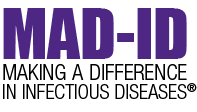Where Are They Now? Q&A with Dr. Taryn Eubank
- lwilliams765
- Mar 6, 2024
- 2 min read
Updated: Jun 23, 2024
By: Cara Slaton, PharmD, BCIDP

Taryn Eubank, PharmD, BCIDP
Dr. Taryn Eubank is an Assistant Professor at the University of Houston College of Pharmacy. She received her PharmD from Harding University College of Pharmacy and went on to complete a PGY-1 residency as well as a PGY-2 in Infectious Diseases at Houston Methodist. Following residency, she received a National Institute of Allergy and Infectious Diseases grant through the Gulf Coast Consortia Training Program in Antimicrobial Resistance to support an Infectious Diseases Research Postdoctoral Fellowship under Dr. Kevin Garey at the University of Houston. Her research interests include antimicrobial resistance, C. difficile, and the gut microbiome.
Research presented at the 2023 MAD-ID Annual Meeting - now published in Clinical Infectious Diseases!
Dr. Eubank and colleagues assessed whether reduced vancomycin susceptibility, defined as a vancomycin minimum inhibitory concentration (MIC) > 2 μg/mL, in C. difficile was associated with decreased rates of sustained clinical response (SCR). The primary outcome of 30-day SCR was lower in the reduced susceptibility group compared to the group without reduced susceptibility (76% vs. 86%, p=0.031), and 14-day initial cure was lower in the reduced susceptibility group compared to the group without reduced susceptibility group (89% vs. 96%, p=0.04).
Questions:
What sparked your interest in conducting research in this area? During my PGY-2, Dr. Kevin Garey was a mentor on my residency research project. This project sparked from this mentorship and offered the best of both worlds for me - studying antimicrobial resistance & C. difficile, a hot topic in stewardship!
What are your thoughts regarding the impact of high oral vancomycin fecal concentrations relative to C. difficile vancomycin MICs? The high concentrations oral vancomycin reaches in the stool (500-2,000 μg/mL) definitely caused me to pause initially as well. However, a couple arguments really stick out to me. Firstly, the 500-2,000 μg/mL concentrations are specifically measured from stool, whereas the concentration along the colon (the site of infection) is most likely not as concentrated especially in patients with C. difficile infection having copious GI motility/diarrhea. Lastly, my colleagues previously demonstrated that these slightly elevated MICs (4-16 μg/mL) correlated with minimum bactericidal concentrations (MBCs) that were profoundly elevated from 64 to >1,000 μg/mL, well within the stool concentration range (PMID: 31873741).
Do you have plans to work on other research related to these findings? Yes! My colleagues and I are working to expand upon these results by looking into the epidemiology behind these elevated MICs in a larger cohort as well as the mechanism of resistance driving these findings. All of this research fits nicely into my research niche: antimicrobial resistance and the human gut microbiome - marry the two together and you get the gut resistome. The resistome is a collective assemblage of antibiotic resistance genes in a microbial ecosystem - our gut! As junior faculty at University of Houston College of Pharmacy, I hope to continue my research career in translational research involving the human gut resistome.
The MAD-ID ‘Where Are They Now?’ series highlights research presented at the MAD-ID Annual Meeting now published in the infectious diseases literature.




Comments